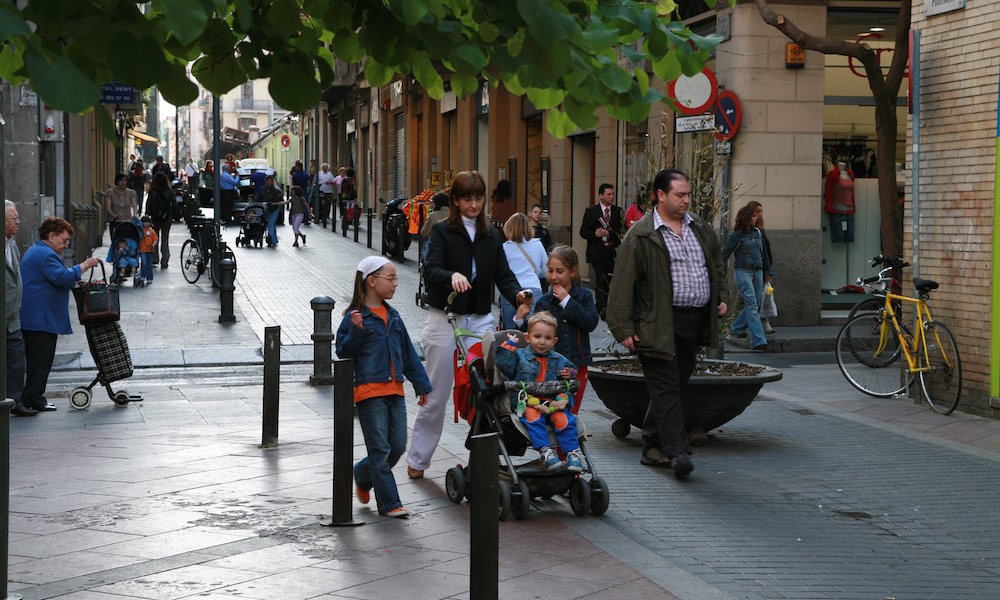The Catalan capital’s radical new strategy will restrict traffic to a number of big roads, drastically reducing pollution and turning secondary streets into ‘citizen spaces’ for culture, leisure and the community.
In the latest attempt from a big city to move away from car hegemony, Barcelona has ambitious plans. Currently faced with excessive pollution and noise levels, the city has come up with a new mobility plan to reduce traffic by 21%. And it comes with something extra: freeing up nearly 60% of streets currently used by cars to turn them into so-called “citizen spaces”. The plan is based around the idea of superilles (superblocks) – mini neighbourhoods around which traffic will flow, and in which spaces will be repurposed to “fill our city with life”, as its tagline says.
This plan will start in the famous gridded neighbourhood of Eixample. That revolutionary design, engineered by Ildefons Cerdà in the late 19th century, had at its core the idea that the city should breathe and – for both ideological and public health reasons – planned for the population to be spread out equally, as well as providing green spaces within each block. Reality and urban development have, however, got the best of it, and as the grid lines became choked with cars, the city’s pollution and noise levels have skyrocketed. What was once a design to make Barcelona healthier, now has to be dramatically rethought for the same reasons.
According to several studies, air pollution alone causes 3,500 premature deaths a year in Barcelona’s metropolitan area (with a population of 3.2 million), as well as having severe effects on local ecosystems and agriculture. Barcelona and the 35 municipalities in its surrounding area have persistently failed to meet EU-established air quality targets.
A study from the local Environmental Epidemiology Agency determined that 1,200 deaths could be prevented in the city yearly just by reaching EU-mandated levels for nitrogen dioxide levels (this would mean a five-month rise in life expectancy). Add to that an estimated 18,700 fewer asthma attacks, 12,100 fewer cases of acute bronchitis and 600 fewer cardiovascular-related hospitalisations, and the problem becomes apparent for a city with a population of 1.6 million. Traffic is also the first cause for noise pollution in the city; 61% of its residents live with noise levels higher than those deemed healthy by legislation.
From our partners:
The council also cites road accidents (9,095 last year, 27 of which were fatal), sedentary lifestyles (one in five kids in Barcelona are overweight or at risk of reaching that state), and the lack of green spaces as reasons driving the plan. The city has only 6.6 sq metres of green space per inhabitant (with the figures standing at just 1.85 in Eixample and 3.15 in Gràcia), closer to Tokyo’s three than to London’s 27, or Amsterdam’s staggering 87.5. The World Health Organisation suggests every city should have at least 9 sq metres per capita.
Barcelona’s new plan consists of creating bigsuperilles through a series of gradual interventions that will repurpose existing infrastructure, starting with traffic management through to changing road signs and bus routes. Superblocks will be smaller than neighbourhoods, but bigger than actual blocks. This will first be applied to Eixample neighbourhood and others like Sant Martí, which largely follows the same grid pattern.
In Eixample, a superblock will consist of nine existing blocks of the grid. Car, scooter, lorry and bus traffic will then be restricted to just the roads in the superblock perimeters, and they will only be allowed in the streets in between if they are residents or providing local businesses, and at a greatly reduced speed of 10km/h (typically the speed limit across the city is 50km/h, and 30km/h in specific areas).

The objectives are ambitious; by implementing these strategies at once, the city wants to reduce car use by 21% over the next two years and increase mobility by foot, bike and public transport. Superblocks will be complemented by the introduction of 300km of new cycling lanes (there are currently around 100km), as well as an orthogonal bus network that has already been put in place, whereby buses only navigate a series of main thoroughfares. This will ensure, says Salvador Rueda, director of the city’s urban ecology agency and one of the drivers of the superblocks idea, that “anyone will be less than 300 metres from a bus stop at any time – and average waiting times will be of five minutes anywhere in the city [current averages stand at 14]”. In addition, “it would be an equitable network in which one could go from any point A to point B with just one transfer in 95% of the cases. Like in a game of Battleship”.
“It’s no surprise that this concept was born here,” said mobility city councillor Mercedes Vidal in the public presentation of the plan this month. “In a city as dense as ours, it’s all the more necessary to re-conquer spaces.” If all goes as planned, around seven of the 13.8 million sq metres now dedicated to motorised traffic will be freed up.
Private vehicles account for just 20% of total movements in the city today and yet they occupy 60% of roads. “We need to win the street back,” says Janet Sanz, city councillor for ecology, urbanism and mobility, who emphasised the need to encourage social cohesion, coexistence and human exchanges. Recently, she remembered the spirit of Jane Jacobs and her activism for the right to the city on the 100th anniversary of the writer and urbanist’s birth: “She proposed giving the street back to the neighbours. Today we work for that objective.”

“This plan sums up the essence of urban ecology,” Sanz adds. “Our objective is for Barcelona to be a city in which to live. Also, as a Mediterranean city, its residents spend a long time on the streets – those streets need to be second homes, or extensions of one’s residence, at all times … Public spaces need to be spaces to play, where green is not an anecdote – where the neighbourhood’s history and local life have a presence.”
“We want these public spaces to be areas where one can exercise all citizen rights: exchange, expression and participation, culture and knowledge, the right to leisure,” Rueda says.
The entire process is being conducted in nine areas at a different pace, through what Sanz called “tactical urbanism” – a gradual trial and error method of sorts, with initial measures such as changing road signs – and with an initial budget of €10m (£7.9m). Now it is time to “go from theory to action”, she says.
The superblocks idea was first outlined in 1987, after noise mapping revealed that levels were too high, and the first superblock was tested in 2003 in Gràcia. Many experiments, like car-free days, have also been conducted in districts like Sant Martí, which will act as the main guinea pig for superblocks. Its city councillor, Josep Maria Montaner, says it has been done in close consultation with groups of neighbours “and it will continue to be so. Neighbours need to experiment it and try the new spaces, little by little – and we hope many of the ideas for how to use them will come from them”.
Rueda says superblocks go back to Cerdà’s philosophy and take it to the next level, to the modern world, by making it live with and for the ecosystem. “We have, as a base [for the plan], Cerdà’s Eixample, which was undermined by greed. What was green in the plan was slowly overtaken and built on. And then, when cars arrived, they slowly overtook more and more space … We want to reclaim those green spaces and that can only be done through a drastic mobility change.”
An Eixample superblock of about 400 x 400 metres, Rueda says, would be inhabited by between 5,000 and 6,000 people. That is “the same as many small towns. Everything we need to consider to face the challenges of this turn of a century – construction, economy, water, residues, metabolisms, social cohesion – should be captured in these superblocks.”
“Every superblock is like a small city with its own character,” the plan suggests. “Imagine what could be done. An Eixample intersection is as big as a Gràcia square,” says Rueda, and he highlights that this new city structure will free up 160 intersections. “I’m already fantasising with neighbourhood-organised inflatable swimming pools in the summer,” he jokes.
This feature originally appeared in The Guardian.


















